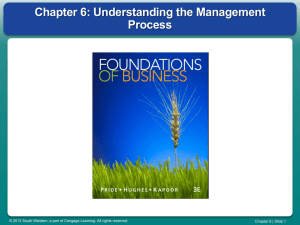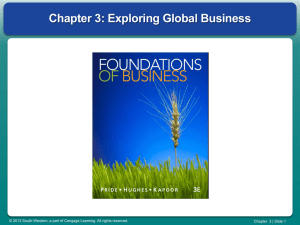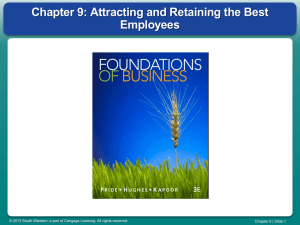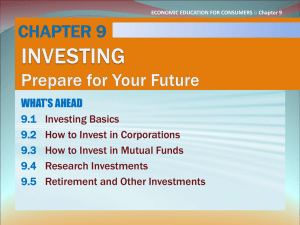Ch 12 PPT Investing in STOCK
advertisement
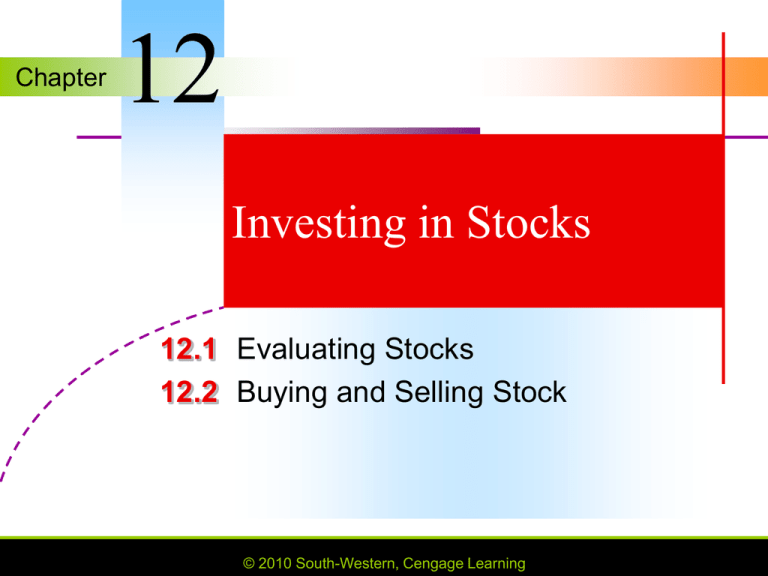
Chapter 12 Investing in Stocks 12.1 Evaluating Stocks 12.2 Buying and Selling Stock © 2010 South-Western, Cengage Learning Lesson 12.1 Evaluating Stocks GOALS Describe features of stock and types of stocks. Explain how to value a stock and decide a fair price to pay for a stock purchase. Chapter 12 © 2010 South-Western, Cengage Learning SLIDE 2 Owning Stock Nearly 50 million people in the United States own stocks. People who own shares of stock are called stockholders, or shareholders, of the corporation. Two ways to profit from owning stock: Dividends are money paid to stockholders from the corporation’s earnings (profits). Capital gain is an increase in the value of the stock over time. Chapter 12 © 2010 South-Western, Cengage Learning SLIDE 3 Common Stock Common stock represents a type of stock that pays a variable dividend and gives the holder voting rights. A proxy is a stockholder’s written authorization to transfer his or her voting rights to someone else, usually a company manager. Chapter 12 © 2010 South-Western, Cengage Learning SLIDE 4 Preferred Stock Preferred stock represents a type of stock that pays a fixed dividend but has no voting rights. Preferred stockholders earn the stated dividend, regardless of how the company is doing. Preferred stock is less risky than common stock. Dividends on preferred stock may be lower than common stockholders would earn, if the company is thriving over time. Chapter 12 © 2010 South-Western, Cengage Learning SLIDE 5 Types of Stock Investments Income stocks Growth stocks Emerging stocks Blue chip stocks Defensive stocks Cyclical stocks Chapter 12 © 2010 South-Western, Cengage Learning SLIDE 6 Income Stocks and Growth Stocks Income stocks are stocks that have a consistent history of paying high dividends. Growth stocks are stocks in corporations that reinvest their profits into the business so that it can grow. Chapter 12 © 2010 South-Western, Cengage Learning SLIDE 7 Emerging Stocks and Blue Chip Stocks Emerging stocks are stocks in young, often small corporations that have higher overall risk than stocks of companies that have been successful for many years. Blue chip stocks are stocks of large, well-established corporations with a solid record of profitability. Chapter 12 © 2010 South-Western, Cengage Learning SLIDE 8 Defensive Stocks and Cyclical Stocks A defensive stock, or non-cyclical stock, is one that remains stable and pays dividends during an economic decline. Cyclical stocks do well when the economy is stable or growing but often do poorly during recessions, when the economy slows down. Chapter 12 © 2010 South-Western, Cengage Learning SLIDE 9 Valuing Stock The par value is an assigned dollar value given to each share of stock. Market value is the price for which the stock is bought and sold in the marketplace. Chapter 12 © 2010 South-Western, Cengage Learning SLIDE 10 Stock Price Factors that affect price include: The company Interest rates The market Earnings per share Chapter 12 © 2010 South-Western, Cengage Learning SLIDE 11 Return on Investment Because you can make money on stocks from dividends and from an increase in the price of the stock (capital gain), you should consider both when computing the return on your investment. Your profit is the difference between what you paid for the stock and what you sold it for, plus any dividends you earned. To compute the total costs, add any commission you paid to the stockbroker to the purchase price of the stock. Chapter 12 © 2010 South-Western, Cengage Learning SLIDE 12 Stock Indexes A stock index is a benchmark that investors use to judge the performance of their investments. Examples of commonly used indexes include: Dow Jones Industrial Average Standard & Poor’s 500 NASDAQ Composite Index Chapter 12 © 2010 South-Western, Cengage Learning SLIDE 13 Lesson 12.2 Buying and Selling Stock GOALS Describe the process of buying and selling stocks. Describe short- and long-term investment strategies when buying and selling stocks. Explain how to read the stock listings and stock indexes. Chapter 12 © 2010 South-Western, Cengage Learning SLIDE 14 The Securities Market A securities exchange is a marketplace where brokers who are representing investors meet to buy and sell securities. The over-the-counter (OTC) market is a network of brokers who buy and sell the securities of corporations that are not listed on a securities exchange. Chapter 12 © 2010 South-Western, Cengage Learning SLIDE 15 Bull and Bear Markets A bull market is a prolonged period of rising stock prices and a general feeling of investor optimism. A bear market is a prolonged period of falling stock prices and a general feeling of investor pessimism. Chapter 12 © 2010 South-Western, Cengage Learning SLIDE 16 Investing Strategies Short-term techniques Buy on margin Sell short Long-term techniques Buy and hold Dollar-cost averaging Direct investment Reinvesting dividend Chapter 12 © 2010 South-Western, Cengage Learning SLIDE 17 Buy on Margin You can borrow money from your broker to buy stock if you open a margin account and sign a contract called a margin agreement. Leverage is the use of borrowed money to buy securities. When the market value of a margined stock decreases to approximately one-half of the original purchase price, the investor will receive a margin call from the broker. This means the investor must pledge additional cash or securities to serve as collateral for the loan. Chapter 12 © 2010 South-Western, Cengage Learning SLIDE 18 Sell Short Short selling is selling stock borrowed from a broker that must be replaced at a later time. To sell short, you borrow a certain number of shares from the broker. You then sell the borrowed stock, knowing that you must buy it back later and return it to the broker. You are betting that the price will drop, so that you can buy it back at a lower price than you sold it for, thus making a profit. Chapter 12 © 2010 South-Western, Cengage Learning SLIDE 19 Long-Term Investing Techniques Buy and hold Dollar-cost averaging Direct investment Reinvesting dividends Chapter 12 © 2010 South-Western, Cengage Learning SLIDE 20 Buy and Hold Most investors consider stock purchases as long-term investments. All stocks go up and down, but over a number of years, the overall trend of non-speculative stocks is moderately up. If you “buy and hold” stocks for many years, you can ride out the down times. When you are ready to sell years later, most likely your stock will have gained value. In addition, many stocks pay dividends, so you are earning income while you hold the stock. Chapter 12 © 2010 South-Western, Cengage Learning SLIDE 21 Stock Split A stock split is an increase in the number of outstanding shares of a company’s stock. When a company increases its number of outstanding shares, it lowers the selling price in direct proportion. A stock split lowers the selling price of the stock, making the shares more affordable and encouraging investors to buy more. As investors buy more stock at the lower price, the share price often rises. If you held the stock before the split, then this price increase makes your stock worth more. Chapter 12 © 2010 South-Western, Cengage Learning SLIDE 22 Dollar-cost Averaging The dollar-cost averaging technique involves the systematic purchase of an equal dollar amount of the same stock at regular intervals. The result is usually a lower average cost per share. Chapter 12 © 2010 South-Western, Cengage Learning SLIDE 23 Direct Investment You can save money using direct investment, or buying stock directly from a corporation. By buying directly, you avoid brokerage and other purchasing fees. You may also be able to obtain shares at prices lower than on open exchanges. Chapter 12 © 2010 South-Western, Cengage Learning SLIDE 24 Reinvesting Dividends Dividend reinvestment means using dividends previously earned on the stock to buy more shares. Buying stock this way avoids a broker fee and other costs that apply, such as taxes, when you receive cash dividends on the stock. Chapter 12 © 2010 South-Western, Cengage Learning SLIDE 25 Reading the Stock Listings Excerpt from stock exchange listings: 52 Wks High Low Stock Div Yld% P/E Ratio Sales 100s High Low Close Net Change 1 2 3 4 5 6 7 8 9 10 11 58.75 44.00 Enger 2.20 4.8 12 109 46.38 45.50 46.00 –.50 45.00 23.00 Eng pf 2.25 8.9 10 25 26.25 24.00 25.38 +.38 10.50 9.00 Entld .10 1.0 3 8 10.13 9.50 10.00 ---- 24.00 16.00 Epsco 1.00 5.0 7 12 21.00 19.00 20.00 +.88 6.38 4.00 Exlab ---- ---- 15 300z 5.75 5.12 5.50 ---- 57.00 32.00 ExeB 2.50 5.7 11 48 46.00 43.00 44.00 +1.00 Chapter 12 © 2010 South-Western, Cengage Learning SLIDE 26 Stock Progress Chart Closing Prices for 10 Days Total Change (+ or –) Stock Names 1 2 3 4 5 6 7 8 9 10 1. Enger 28.00 28.12 29.00 28.00 27.00 28.00 28.50 29.00 29.50 30.00 +2 2. Glastn 38.00 40.00 41.00 41.50 –– 40.00 39.00 38.00 38.00 38.00 0 3. Karbr pf 61.00 61.25 61.13 61.00 61.38 61.00 62.00 62.38 61.00 61.13 +.13 4. Maxln 50.13 49.00 50.00 50.25 51.00 51.00 51.13 52.00 52.00 53.50 +3.37 5. Totlmb 10.00 11.00 11.13 11.50 11.00 10.88 10.00 9.00 8.00 8.50 –1.50 Chapter 12 © 2010 South-Western, Cengage Learning SLIDE 27
